The Shale Hill Workout
As we walked towards the starting line, Rita Beardmore pointed at my ankles and laughed hard.
“Say goodbye to your socks,” she said.
Beardwood’s joke held a degree of seriousness. After several weeks of rain, anyone setting foot on the Shale Hill obstacle course was going to emerge in need of a shower and a change of clothes. While my pristine white cotton socks labeled me a rookie, for the two men and three women clad in Lycra and cross-country running cleats, the morning run was just another workout.
“Who knows,” Beardwood said, “You just might be cut out for this.”
After ringing a bell affixed to a pole at the starting line, we took off down the hill.
Made famous by mega-events such as the Reebok Spartan Race and the Tough Mudder, the modern obstacle course race has become synonymous with full-body suffering. Every year, thousands of people sign up to leap over fire pits, throw spears at targets, crawl through flooded culverts, run through exposed electrical cables and much more. In Benson, Vt., 27 miles northwest of Rutland, course builder Rob Butler has designed one of only a handful of locations where athletes can go to train for these kinds of races. Or just simply get a full-body workout.
At 5:30 on a misty Tuesday morning, I joined a group of five athletes completing a month-long residency at Butler’s Shale Hill Adventure Farm. In addition to running the course every morning, their program included trail runs up Killington Mountain and intense workouts with athletic coaches at Middlebury College. Along the way the residents were asked to reflect on their experiences and track their progress in videos and journals. Beardmore, who greeted me at my arrival, was a competitive weightlifter before injury forced her to retire. She discovered obstacle racing when a friend invited her on a race.
“Everybody comes here with a different story,” she said.
Some were looking to get in shape while others had their sights on elite-level competition. When I met them on the tenth day of their stay, the group was starting to see some progress.
Featuring 5K and 10K loops, the courses at Shale Hill don’t just wear you down; they chew you up and spit you out. It was nothing like the muddy cross-country meets I ran all over the state in high school or the flat and fast 400-meter races in track and field. Instead, it pounded me into the mud over 10 kilometers and then slowly roasted me as the early July sun rose above the Champlain Valley.
But I wasn’t alone while I fought my way through the no-man’s-land of hay bales, barbed wire and ropes. Running alongside me through the fields, swamps and woods was Butler, the mastermind behind the course. Having designed and built the course and having spent countless hours practicing on it, Butler practically floated over the rugged terrain, dropping pointers for me as we scaled walls, crawled through tunnels and hauled five-gallon buckets loaded with rocks.
The secret, he told me, is repetition.
“When you repeat something so many times, your body begins to accept it,” he said while I waded hip-deep through a bog. “If you listen to your body and treat it right, after three weeks, the motions become second nature.”
While it’s hard to see how some of these challenges could become second nature, Butler is relentlessly encouraging; no matter your goals for the course, he’s got a way of getting you across the finish line. They guy will house you, train you and even let you demo a pair of technical cross-country running shoes. Just expect no mercy from the over 50 obstacles with such ominous names such as Heinous Hoist, Pick your Poison, Haybales from Hell and Anaconda.
Sometimes the barbed wire wins. Sometimes the rope spanning the duckweed-covered pond sends you for a dip. Vaulting an 11-foot wall like Clint Eastwood in Escape from Alcatraz can seem like a Herculean task. But the course doesn’t have to be all suffering and no fun, with a little preparation at the gym or even your backyard.
Here’s the Shale Hill workout, as approved by the guy who knows it best: Rob Butler himself.
Pond Traverse 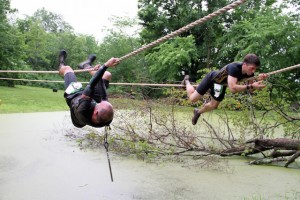
At the western edge of the course is the pond traverse, which consisted of crossing the pond on 30-foot lengths rope suspended four to five feet above the water. As Butler showed me, you can either drape yourself over the rope and slide along or grip the rope with your ankles and hands and alternate hand-over-hand. It felt fun for the first six feet, but the novelty quickly wore off near the middle, when I began to climb slightly uphill to the end. It’s an obstacle that requires core and grip strength as well as coordination. A few simple exercises that would have prepared me for this: pull-ups, bear crawls and knee-to-elbow crunches. Since the traverse can last longer than expected, Butler recommends you practice these workouts for duration instead of reps.
Or you could strap on a life jacket and swim the pond—we won’t judge you.
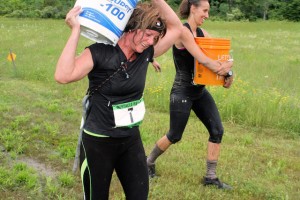 Carries: Logs, sand tubes and buckets of rocks
Carries: Logs, sand tubes and buckets of rocks
There are three points in the Shale Hill course where I had to haul some heavy object for distances of up to a half-mile. They included logs, PVC tubes filled with sand and five-gallon buckets of rocks. Fortunately, heavy menial labor is part of life in New England. I carry and stack cords of wood, haul bags of manure out to the garden and shovel myself out of the house in the winter. But there’s no comfortable way to carry 30 pounds of rocks in a plastic sheetrock bucket by a thin metal handle. As Butler noted, by practicing carries with varying times and distances you can get tougher. On 24-hour races when competitors complete the course as many times as possible, the carries often push to the breaking point. By lap seven, as Butler said, there’s no way to around it but to stay tough and refuse to quit.
“When you commit yourself to it, you reach a point of indifference,” he said. “What’s just another few feet of pain?”
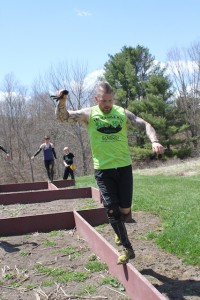
Balance beams
Requiring more balance and agility than strength, the balancing acts on the course included walking two-inch wide planks inserted in the ground and then along 20-foot tree trunks that span a ravine. The aggressive treads on the Icebug sneakers I borrowed provided a good amount of stability, inspiring the briefest flicker of confidence. But as I discovered the hard way: neglect your balance and you’ll find yourself stuck.
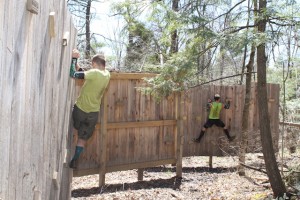 Great Wall traverse
Great Wall traverse
Located in a densely wooded area of the course Butler referred to as “the jungle,” the wall traverse included hand and foot holds made from wooden blocks placed at varying angles spaced apart (gripping the top of the wall is prohibited). The wall traverse relies on grip strength, good foot placement skills and muscular endurance. Butler suggested that if you want to work on these, to practice on a low bouldering wall, paying attention to how your body moves most efficiently. A common mistake I found was to use your arms to haul yourself along. Your legs are stronger, so use them to propel you while your arms stabilize your upper body. When you get on the wall, alternate how you grip the blocks (pinching, crimping and under-clinging) to save your strength. That wall’s a lot longer than you think (as I found) so don’t forget to keep breathing and take your time.
Heinous Hoist
This aptly named obstacle was the real soul-crusher: a 95 pound concrete block on a rope that racers on the 10K course had to hoist 15 feet off the ground five times. That’s a lot of heavy lifting – and it feels even heavier since it comes two miles into the race. Channeling my inner Hulk Hogan, I managed three hoists before Butler mercifully permitted me to say “uncle.”
The obstacles on this and many courses require lots of pulling (not so much pushing), which you can easily adopt in your gym training by doing pull-ups, squats and hollow-body holds will strengthen your shoulders, grip strength and hip flexors.
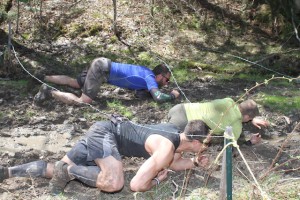 Barbed wire crawl
Barbed wire crawl
Fact: Barbed wire hurts. Another fact: crawling under it through tall grass or mud isn’t much fun either. It’s a deceptive challenge that most people underestimate because it involves coordinating opposite limbs; in a proper crawl, one arm extends forward with the opposite knee. Butler suggested the way to practice this is to hold the classic plank position for as long as you can and pair it with knee to elbow push-ups or mountain-climbers.
Pick your poison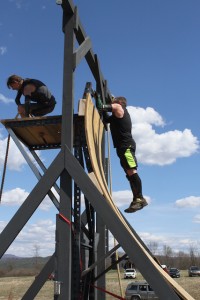
Rising fifteen feet of the ground, this wooden ramp looked like something out of a skate park. The key here, I found, was to take off at a dead run towards it and sprint up the incline as fast as I could. When I felt like I was about to slip, I made a vertical leap and prayed I reached the bar. Once at the top, I lowered myself to the ground by way of a rope and charged toward the last obstacle on the course
It took me just over two hours to complete the course. As Rob and I hustled our way back up the hill, and crossed the finish line we met the group’s lone Quebecois Vincent Larochelle, who had started with us but was already showered and enjoying the morning sun in an Adirondack chair. On the day of my visit, Larochelle cranked out a couple of four-minute miles and then finished the morning obstacle course workout in about an hour.
A carpenter by trade, Larochelle has had three podium finishes at international Spartan races. With the help of Butler, he hopes to compete at the 2015 World Championships at Squaw Valley, California in October, where 600 of the fastest obstacle racers in the world will race at elevation for $100,000 in prize money.
“What did you think?” he asked, offering me a high-five.
Mud-covered, bleeding and sore all over, I managed a nod and a toothy grin.
“C’est bon,” I said. “It’s good.”



